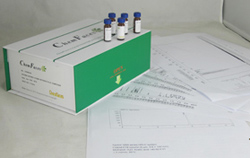Hot Products



| Catalog No. | Information |
| CFN92266 | Dulcoside A Dulcoside A is a sweetener and has antioxidant activity. |
| CFN92882 | Ebracteolata cpd B |
| CFN92873 | Ebracteolatanolide A Standard reference |
| CFN90414 | Eburicoic acid Eburicoic acid and TR2 have anti-inflammatory activity, the mechanism is related to the decrease of inflammatory cytokines and an increase of antioxidant enzyme activity, they protect the liver from CCl4-induced hepatic damage via antioxidant and anti-inflammatory mechanisms. Eburicoic acid has significant anti-liver cancer effects and more distinctive mechanisms. |
| CFN97175 | Eburicol Mutations in the Eburicol gene impact on the activity of the Eburicol protein. Eburicol inhibit the large accumulation of C-14 methyl sterols and cell lysis when the content of ergosterol becomes too low in the actively growing cells. |
| CFN00254 | Echimidine Echimidine, a major hepatotoxic dehydropyrrolizidine alkaloid produced by E. plantagineum, in the honey (780 ng/g) and in the subsequent mead samples (236–540 ng/mL). Echimidine-N-Oxide has antifungal activity. |
| CFN00452 | Echimidine N-oxide |
| CFN98105 | Echinacoside Echinacoside is a natural polyphenolic compound, has various kinds of pharmacological activities, such as anti-senescence, anti-hypoxia, anti-cancer, anti-osteoporosis, antioxidative, anti-inflammatory, neuroprotective, hepatoprotective, nitric oxide radical-scavenging and vasodilative ones. Echinacoside can improve the hematopoietic function of bone marrow in 5-FU-induced myelosuppression mice, it induces apoptotic cancer cell death by inhibiting the nucleotide pool sanitizing enzyme MTH1. Echinacoside inhibits cytochrome c release and caspase-3 activation caused by ensuing rotenone exposure via activating Trk-extracellular signal-regulated kinase (ERK) pathway in neuronal cells. |
| CFN99520 | Echinatin Echinatin has significant antioxidant and anti-inflammary activities, it shows strong scavenging activity toward the ABTS + radical, it also inhibits the production of nitric oxide (NO), interleukin-6 (IL-6) and prostaglandin E2 (PGE2) in LPS-induced macrophage cells. Echinatin disturbs the mitochondrial energy transfer reactions and membrane permeability, at a low concentration cause deterioration of respiratory control and oxidative phosphorylation of isolated rat liver mitochondria, inhibits DNP-ATPase activity while stimulating range latent ATPase activity. |
| CFN00255 | Echinatine Echinatin exerts a protective effect against ischemia/reperfusion (I/R)-induced myocardial injury on hearts, this effect may be attributed to the antioxidant and anti-inflammatory activities of this compound. Echinatin can inhibit DNP-ATPase activity while stimulating range latent ATPase activity in the low concentration, so echinatin can disturb the mitochondrial energy transfer reactions and membrane permeability. |